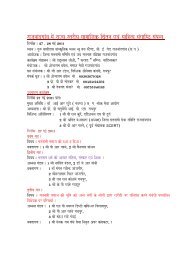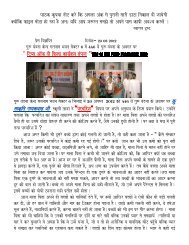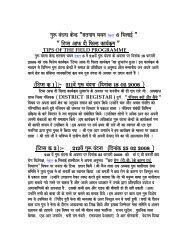Revolution and Counter-Revolution in Ancient India - Satnami.com
Revolution and Counter-Revolution in Ancient India - Satnami.com
Revolution and Counter-Revolution in Ancient India - Satnami.com
You also want an ePaper? Increase the reach of your titles
YUMPU automatically turns print PDFs into web optimized ePapers that Google loves.
could hardly afford such a potent <strong>in</strong>strument of military dom<strong>in</strong>ation to be offered<br />
as sacrifice. The sacrifice must have been revolt<strong>in</strong>g <strong>in</strong> as much as one of the<br />
rituals <strong>in</strong> the horse-sacrifice was the copulation of the horse before it was<br />
slaughtered with the wife of the sacrificer.<br />
The animals most <strong>com</strong>monly offered for sacrifice were of course the cattle<br />
which were used by the people for their agricultural purposes. They were mostly<br />
cows <strong>and</strong> bullocks.<br />
The Yadnas were costly <strong>and</strong> they would have died out of sheer considerations<br />
of expense <strong>in</strong>volved. But they did not. The reason is that the stoppage<br />
of Yadna<strong>in</strong>volved the question of the loss of the Brahm<strong>in</strong>'s fees. There could be<br />
no fees if the Yadna ceased to be performed <strong>and</strong> the Brahm<strong>in</strong> would starve. The<br />
Brahm<strong>in</strong> therefore found a substitute for the costly sacrificial animals. For a<br />
human sacrifice the Brahm<strong>in</strong> allowed as a substitute for a live man, a man of<br />
straw or metal or earth. But they did not altogether give up human sacrifice for<br />
fear that this Yadna might be stopped <strong>and</strong> they should lose their fees. When<br />
human sacrifice became rare, animal sacrifice came <strong>in</strong> as a substitute. Animal<br />
sacrifice was also a question of expense to the laity. Here aga<strong>in</strong> rather than<br />
allow the sacrifice to go out of vogue, the Brahm<strong>in</strong>s came forward with smaller<br />
animals for cattle just as cattle had been allowed to take the place of the man<br />
<strong>and</strong> the horse. All this was for the purpose of ma<strong>in</strong>ta<strong>in</strong><strong>in</strong>g the Yadna so that the<br />
Brahm<strong>in</strong> did not lose his fees which was his ma<strong>in</strong>tenance. So set were the<br />
Brahm<strong>in</strong>s on the cont<strong>in</strong>uance of the Yadnathat they were satisfied with merely<br />
rice as an offer<strong>in</strong>g.<br />
It must not however be supposed that the <strong>in</strong>stitution of substitutes of<br />
the Yadnas of the Aryans had be<strong>com</strong>e less horrid. The <strong>in</strong>troduction of<br />
substitutes did not work as a <strong>com</strong>plete replacement of the more expensive <strong>and</strong><br />
more ghastly sacrifice by the less expensive <strong>and</strong> the more <strong>in</strong>nocent. All that it<br />
meant was that the offer<strong>in</strong>g may be accord<strong>in</strong>g to the capacity of the sacrificer. If<br />
he was poor his offer<strong>in</strong>g may be rice. If he was well to do it might be a goat. If he<br />
was rich it might be a man, horse, cow or a bull. The effect of the subsitutes was<br />
that the Yadna was brought with<strong>in</strong> the capacity of all so that the Brahm<strong>in</strong> reaped<br />
a larger harvest of feast on the total. It did not have the effect of stopp<strong>in</strong>g animal<br />
sacrifice. Indeed animals cont<strong>in</strong>ued to be sacrificed by the thous<strong>and</strong>s.<br />
The Yadna often became a regular carnage of cattle at which the Brahm<strong>in</strong>s did<br />
the work of butchers. One gets some idea of the extent of this carnage of<br />
<strong>in</strong>nocent animals from references to the Yadnas which one <strong>com</strong>es across<br />
<strong>in</strong> Buddhist literature. In the Suttanipat a description is given of the Yadna that<br />
was arranged to be performed by Pasenadi, k<strong>in</strong>g of Kosala. It is stated that there<br />
were tied to the poles for slaughter at the Yadna five hundred oxen, five hundred<br />
bulls, five hundred cows, five hundred goats <strong>and</strong> five hundred lambs <strong>and</strong> that






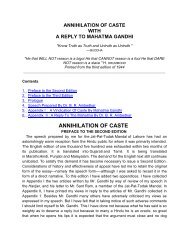


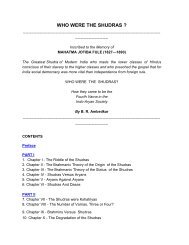

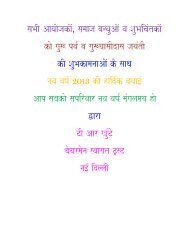
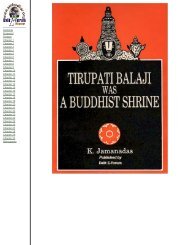
![saaQa satnaamaI saaQa satnaamaI ]%tr Baart ka mah%vapUNa ...](https://img.yumpu.com/5897453/1/190x245/saaqa-satnaamai-saaqa-satnaamai-tr-baart-ka-mahvapuna-.jpg?quality=85)
